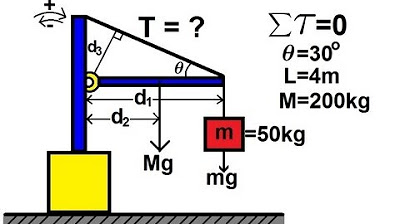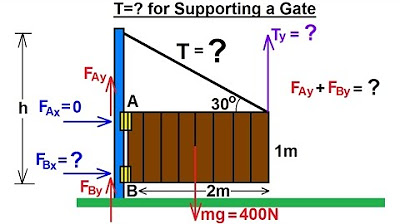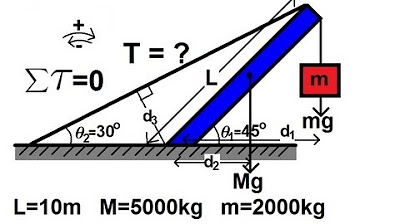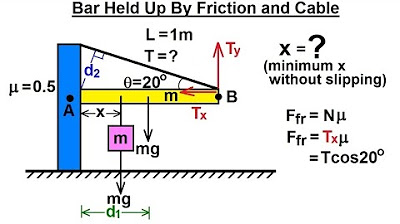Physics 15 Torque (19 of 25) More Examples: 1 T=? of Cable Holding Fish
TLDRIn this educational transcript, a problem involving torque is solved using the principle of equilibrium. A 5,000 Newtons weight, representing a large fish, hangs from a 2-meter long beam that is inclined at 30 degrees to the vertical and pivots at the bottom. A cable, making a 20-degree angle with the horizontal, supports the beam and the fish. To find the tension in the cable, the sum of torques around the pivot point is set to zero. The weight of the beam and the fish contribute negative torques, while the tension in the cable provides a positive torque. By calculating the perpendicular distances of the forces relative to the pivot point and applying trigonometric functions, the tension in the cable is determined to be 2,792 Newtons, providing a clear solution to the problem.
Takeaways
- 📐 The problem involves calculating the tension in a cable holding up a beam and a fish, with the system in equilibrium.
- 🐟 The fish has a weight of 5000 Newtons, and the beam is 2 meters long, making a 30-degree angle with the vertical.
- 🔴 Torque is calculated around a pivot point (point A), and the sum of all torques must equal zero for equilibrium.
- ⚖️ The forces involved are the weight of the beam, the weight of the fish, and the tension in the cable.
- 📏 The distances from the line of action of each force to the pivot point are crucial for calculating torques.
- 📐 The perpendicular distance from the line of action of the cable's tension to the pivot point is found using trigonometry.
- 🔵 The negative torque is caused by the weight of the beam and the fish, while the positive torque is due to the tension in the cable.
- 🧮 The torque equation is set up by multiplying each force by its respective perpendicular distance and summing them to zero.
- 📐 The length of the beam (L) is used to express the distances d1 and d2 in terms of trigonometric functions.
- ✅ After canceling out the common factor (L), the equation is solved for the tension (T) in the cable.
- 🔢 The final calculation involves the sine and cosine of specific angles (30 degrees and 10 degrees) to find the tension in the cable.
- 🎯 The calculated tension in the cable is 2792 Newtons, which is the solution to the problem.
Q & A
What is the weight of the fish in the problem?
-The weight of the fish is 5,000 Newtons.
What is the length of the beam in the problem?
-The beam is 2 meters long.
What is the angle made by the beam relative to the vertical?
-The beam makes an angle of 30 degrees relative to the vertical.
What is the angle made by the cable relative to the horizontal?
-The cable makes an angle of 20 degrees relative to the horizontal.
What is the condition for equilibrium in the problem?
-The condition for equilibrium is that the sum of all the torques about point A must add up to 0.
What are the three forces causing torque in the problem?
-The three forces causing torque are the weight of the beam, the weight of the fish, and the tension of the cable.
How is the perpendicular distance from the line of action of the force to the pivot point calculated?
-The perpendicular distance is calculated by considering the geometry of the forces and the angles involved, using trigonometric functions such as sine and cosine.
What is the relationship between the angles in the problem when finding the perpendicular distance for the tension?
-The relationship is that the angle between the tension and the perpendicular to the beam is found by subtracting the angle of the cable (20 degrees) from the angle of the beam (30 degrees), resulting in a 10-degree angle.
What trigonometric function is used to find the perpendicular distance from the line of action of the tension to the pivot point?
-The cosine function is used, specifically the cosine of the 10-degree angle between the tension and the perpendicular to the beam.
What is the final calculated tension in the cable?
-The final calculated tension in the cable is 2,792 Newtons.
How is the final tension value derived?
-The final tension value is derived by setting the sum of all torques equal to zero, solving for the tension (T), and then using trigonometric relationships to find the numerical value.
What is the significance of the equilibrium condition in this problem?
-The significance of the equilibrium condition is that it allows us to analyze the system of forces acting on the beam and fish, and to calculate the unknown tension in the cable using torque analysis.
Outlines
🔍 Analyzing Torque with a Hanging Fish Problem
This paragraph introduces a physics problem involving a large fish weighing 5,000 Newtons suspended from a 2-meter long beam, which is attached to a hinge (pivot point A) and forms a 30-degree angle with the vertical. A cable is also holding the beam and the fish, making a 20-degree angle with the horizontal. The goal is to find the tension in the cable. The problem is approached by applying the principle of equilibrium, which states that the sum of torques about point A must be zero. The forces considered are the weight of the beam acting at its center of mass, the weight of the fish, and the tension in the cable. The distances of these forces from the pivot point are also discussed. The paragraph concludes with the setup for calculating the torques and the equation for the sum of torques, which includes the weight of the beam, the weight of the fish, and the tension in the cable.
🧮 Calculating the Tension in the Cable
The second paragraph continues the problem-solving process by calculating the tension in the cable. It begins by addressing the need to find the perpendicular distances of the forces from the pivot point, which are crucial for calculating the torques. The paragraph explains how to find these distances using trigonometric relationships based on the angles given. The tension's perpendicular distance is particularly challenging, but it is resolved by considering the angles formed by the beam and the cable. The paragraph then proceeds to set up the equation for the sum of the torques, taking into account the negative and positive directions of the torques caused by the different forces. After substituting the known values and simplifying the equation by canceling out the common factor (the length of the beam, L), the tension in the cable (T) is solved for. The final calculation involves trigonometric functions of the given angles, and the paragraph concludes with the result that the tension in the cable is 2,792 Newtons.
Mindmap
Keywords
💡Torque
💡Equilibrium
💡Beam
💡Pivot Point
💡Tension
💡Angle
💡Center of Mass
💡Perpendicular Distance
💡Cosine and Sine
💡Newton
💡Summation of Torques
Highlights
The problem involves using torque to find the tension in a cable holding a fish with a weight of 5,000 Newtons.
A beam is used, 2 meters long, making a 30-degree angle with the vertical, and is attached to a hinge at the bottom.
The cable holding the beam and fish is at a 20-degree angle relative to the horizontal.
The equilibrium condition states that the sum of all torques about point A must equal zero.
Three forces are identified: the weight of the beam, the weight of the fish, and the tension of the cable.
The weight of the beam acts at the center of mass, causing a negative torque due to its downward direction.
The weight of the fish also causes a negative torque as it pulls downward.
The tension in the cable causes a positive torque, counteracting the negative torques.
The perpendicular distance from the line of action of each force to the pivot point is crucial for calculating torque.
The perpendicular distance for the tension is found by considering the angle between the tension and the perpendicular to the beam.
The angle between the tension and the perpendicular to the beam is determined to be 10 degrees.
The torque caused by the tension is calculated using the length of the beam and the cosine of the 10-degree angle.
The problem is solved by setting the sum of torques equal to zero and solving for the tension T.
The tension in the cable is calculated to be 2,792 Newtons after applying trigonometric functions.
The use of trigonometric functions and the equilibrium condition is key to solving the problem.
The problem demonstrates the practical application of torque in real-world scenarios, such as calculating forces in a mechanical system.
The solution process involves a step-by-step approach, making it easier to understand and follow.
The final answer is obtained by simplifying the equation and applying basic trigonometric identities.
Transcripts
Browse More Related Video

Physics 15 Torque Example 1 (1 of 7) Mass on Rod and Cable

Physics 15 Torque (5 of 27) Tension=? Supporting a Gate

Physics 15 Torque Example 2 (2 of 7) Mass on Rod and Cable

Physics 15 Torque Example 3 (3 of 7) Mass on Rod and Cable

Physics 15 Torque (4 of 27) Bar Held Up by Friction

Physics 15 Torque (3 of 27) Tension=? in the Cable
5.0 / 5 (0 votes)
Thanks for rating: